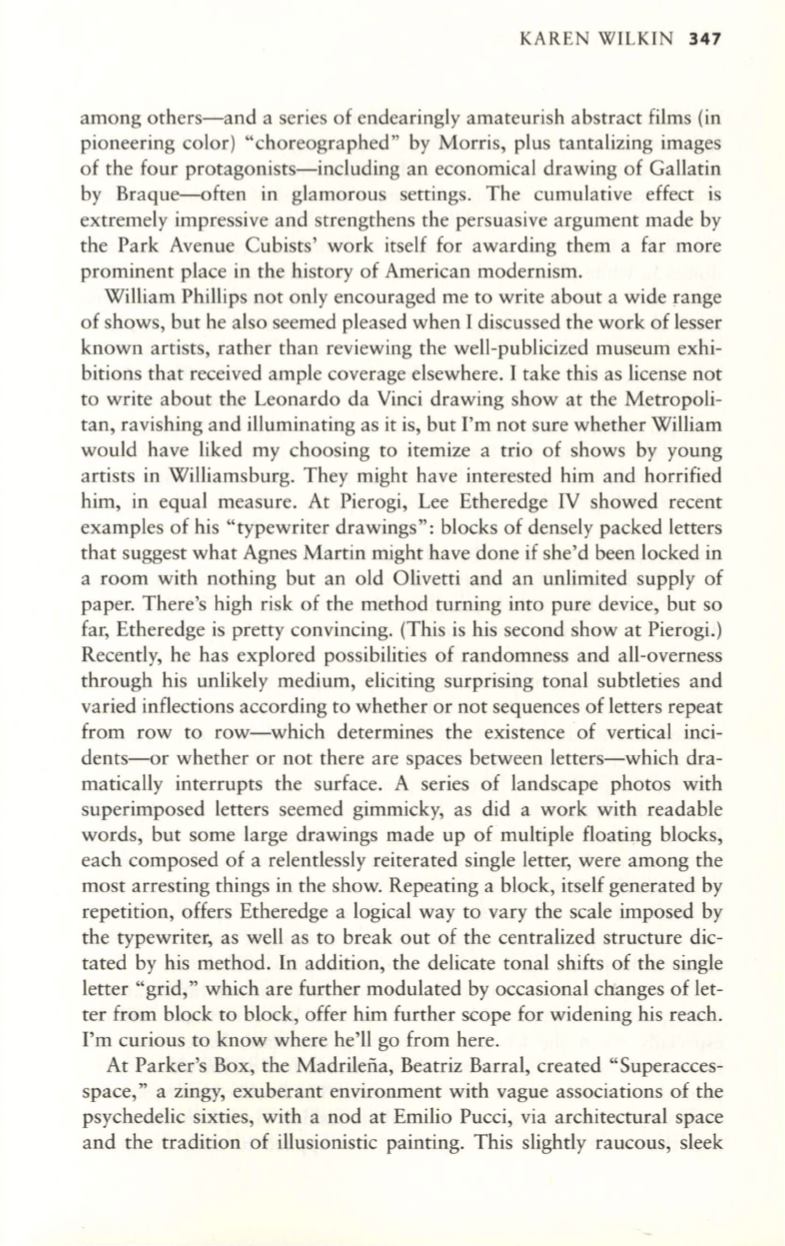
KAREN WILKIN
347
among others-and a series of endearingly amateurish abstract films (in
pioneering color) "choreographed" by Morris, plus tantalizing images
of the four protagonists-including an economical drawing of Gallatin
by Braque-often in glamorous settings. The cumulative effect is
extremely impressive and strengthens the persuasive argument made by
the Park Avenue Cubists' work itself for awarding them a far more
prominent place in the history of American modernism.
William Phillips not only encouraged me to write about a wide range
of shows, but he also seemed pleased when I discussed the work of lesser
known artists, rather than reviewing the well-publicized museum exhi–
bitions that received ample coverage elsewhere. I take this as license not
to write about the Leonardo da Vinci drawing show at the Metropoli–
tan, ravishing and illuminating as it is, but I'm not sure whether William
would have liked my choosing to itemize a trio of shows by young
artists in Williamsburg. They might have interested him and horrified
him, in equal measure. At Pierogi, Lee Etheredge IV showed recent
examples of his "typewriter drawings": blocks of densely packed letters
that suggest what Agnes Martin might have done if she'd been locked in
a room with nothing but an old Olivetti and an unlimited supply of
paper. There's high risk of the method turning into pure device, but so
far, Etheredge is pretty convincing. (This is his second show at Pierogi.)
Recently, he has explored possibilities of randomness and all-overness
through his unlikely medium, eliciting surprising tonal subtleties and
varied inflections according to whether or not sequences of letters repeat
from row to row-which determines the existence of vertical inci–
dents-or whether or not there are spaces between letters-which dra–
matically interrupts the surface. A series of landscape photos with
superimposed letters seemed gimmicky, as did a work with readable
words, but some large drawings made up of multiple floating blocks,
each composed of a relentlessly reiterated single letter, were among the
most arresting things in the show. Repeating a block, itself generated by
repetition, offers Etheredge a logical way to vary the scale imposed by
the typewriter, as well as to break out of the centralized structure dic–
tated by his method. In addition, the delicate tonal shifts of the single
letter "grid," which are further modulated by occasional changes of let–
ter from block to block, offer him further scope for widening his reach.
I'm curious to know where he'll go from here.
At Parker's Box, the Madrilena, Beatriz Barral, created "Superacces–
space," a zingy, exuberant environment with vague associations of the
psychedelic sixties, with a nod at Emilio Pucci, via architectural space
and the tradition of illusionistic painting. This slightly raucous, sleek


